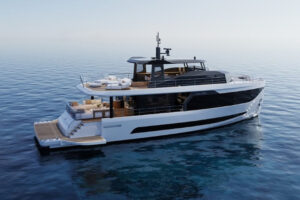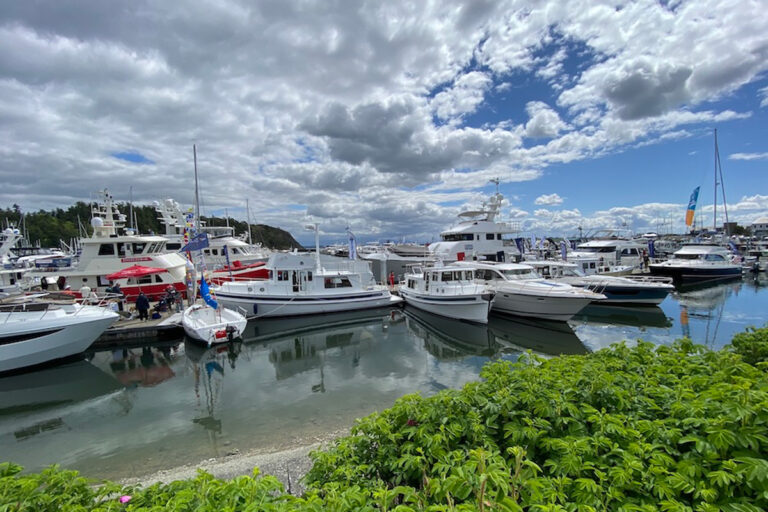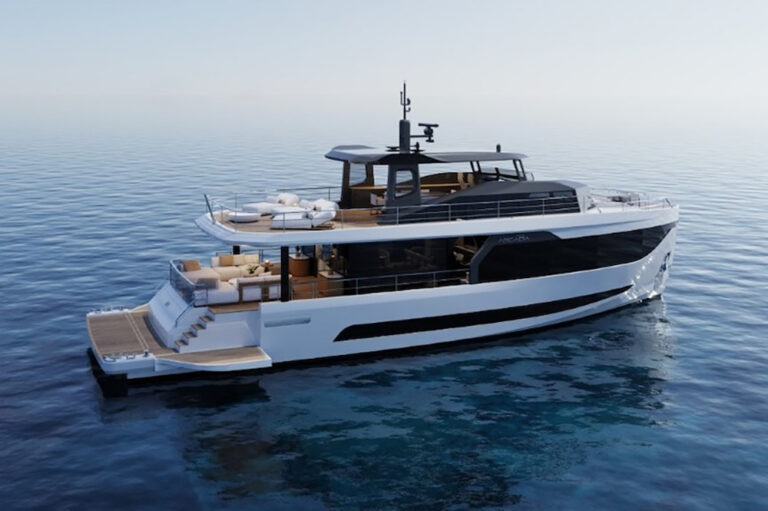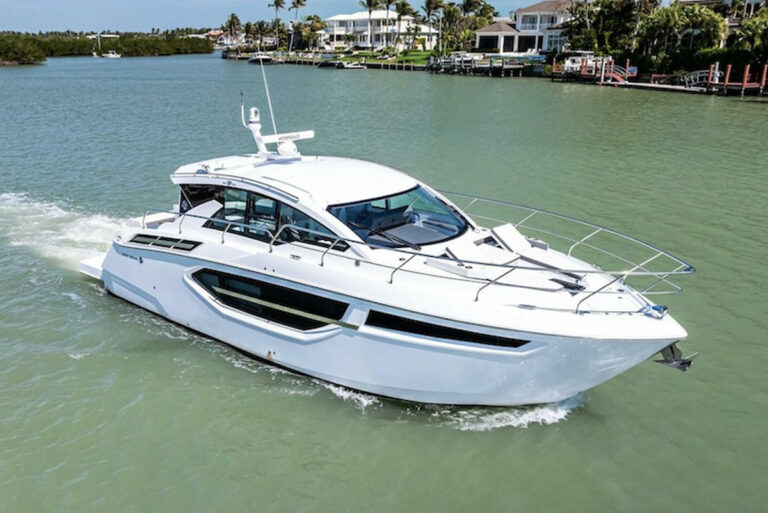
Riva has been building boats for 170 years. During those years, the company has distinguished itself as the creator of very fashionable wooden runabouts, the timeless Riva designs used by the rich and famous. But this reputation for quality and style has grown well beyond the classic launches that first established the Riva brand. The 63 Virtus is the latest yacht in Riva’s Open range of highly regarded express cruisers. If visual appeal is what counts, the 63 is already a winner.
This sport cruiser seems to be all hull. Only the windscreen and the mast rise above the deck line, which makes for a very tall structure above the static waterline. To reduce the apparent height, the designers have divided the topsides with a long line of recessed windows and a scalloped channel that leads into the air intakes aft. The pronounced reverse sheer line adds the final element to this yacht’s high-performance aura.
She’s also two yachts in one. For open-air living, day or night, everything is in the cockpit — a dining area, a sun pad, a barbecue counter and the helm station. Two opposing settees with a fold-out table between them invite guests to chat over cocktails, and later, the starboard-side settee can be moved across to close up the table seating for dinner while still leaving a clear passageway behind it. Nearby, the barbecue and bar counter lets the owner (or crew) prepare a casual meal. The full galley below, equipped with Miele appliances, can serve as the backup if the party topside overtaxes the barbecue. There is more seating around the base of the curved mast, which rakes forward to support the antennas, radome and the like. The sun pad aft looks supremely comfortable.
Click here to see a full photo gallery of the Riva 63 Virtus.

Located below the sun pad, the tender garage features a simple fold-out slipway system that makes vessel launch and recovery quick and easy. Ring fairleads aft look very sexy, but their sharp edges could lead to lines chafing if moored up for any length of time.
At this 63’s helm station, a three-person bench seat faces the vertical wheel and throttles, an easy arm’s reach away. To the right of the throttles are the bow-thruster control and the trim tabs, but I found the latter one to be rarely needed. You can just open up the throttles and go.
At the top of the dash is the easily viewable electronic navigation display with three smaller displays found beneath it. The two outer ones provide engine data, and the central one offers vessel information, including the trim-tab settings.
The fly in the 63’s ointment is the windshield. The stylists have insisted on tinted glass, and in the bright sun of the sea trial this darkened windshield and the reflections on it from the dash below compromised the view ahead. I found it hard to pick out detail, and even though I’m 6 feet tall, I had to stand on my tiptoes to see over it. When you have a boat traveling at close to 40 knots, this is not an optimal situation. I was under the impression that EU regulations had banned tinted windshields, but Riva’s technical staff assured me that this is not the case.
An electronically operated Bimini top that rises from around the front of the helm to shelter the driver and his companions is secure enough to run with it up. I would add more handholds in the expansive cockpit to offer better security when moving about at speed.
Each owner can choose his own interior design, and the one on this Riva created a very restful feeling. Natural oak was selected for the furniture, some of the paneling and the soles. It had been cleverly paired with the darker tones of the surrounding leather and polished lacquerwork. Excellent sound attenuation made this area a haven of relaxation. Large, long side windows enhance the feeling of space with ambient light, and there is an average headroom of 6 feet 6 inches.
Two large staterooms, one forward and one abaft the salon, dominate the layout, and both of these staterooms could pass muster as a master. A smaller, two-bunk cabin tucked away on the port side may best be described as a kid’s cabin. This one shares the shower-equipped day-head that lies at the foot of the stairs on the starboard side.
The forepeak VIP welcomes its occupants with a large step-up berth surrounded by wraparound windows and paneling. There are plenty of stowage areas and shelves, including a large closet. Light-tone fabrics and oak have been used to help emphasize the sense of space here. This en suite head is more compact than the one for the after stateroom, and that might be an owner’s deciding factor when determining which should be the master.
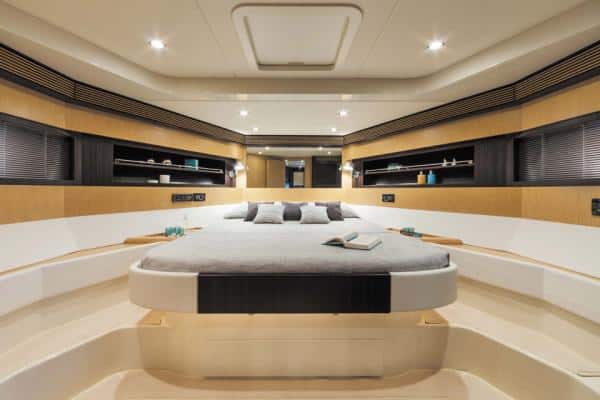
That after stateroom also features a queen-size berth but has its head on the outboard side, so there is no chance of a view through the hull-side windows. Large mirrors help create an open feeling, though, and a drop-down panel below the TV serves as a desk or a vanity unit. Superb fit and finish can be seen in the white leather around the berth. This is an intimate stateroom where the sense of space belies the fact that it’s installed on a 63-footer.
Equally well outfitted is the belowdecks salon where a large table seats six or more for convivial meals. A comprehensively fitted galley sits opposite and is equipped for sophisticated meal preparation. The whole galley can be closed off, transforming it into an oak-enshrined bar counter.
This yacht’s interior appointments have serious eye appeal, but the 63 is designed for the open sea as well. The Mediterranean was not in a cooperative mood when we set out for our sea trial. Twenty-knot winds created steep and challenging four-foot seas. I always feel some nervousness when I open up the throttles in these conditions, but the 63 soon showed that she could perform in the rough stuff. She was highly responsive to steering input, making near-40-knot speeds, while that windscreen offered good shelter from the wind.
Her deep-V hull form, which sports a 17-degree deadrise, treated the angry sea with some disdain. This is a heavy boat, tipping the scales at more than 30 tons (full load), and with this weight she is less affected by the waves. Riva claims it has achieved 40-plus knots with the yacht with a light-ship payload. (Our test boat topped out at 38.6 knots.)
As stylish as she is, it came as some surprise to find such superb performance. In the marina her idle speed is a bit fast, but a trolling valve can be utilized to bring the gears down to a more controllable pace.
Her power comes from a pair of V-12 MAN diesels, each one producing 1,360 horsepower, coupled first to V-drive gear boxes and then to a conventional shaft-and-propeller system. Some whine from the gear boxes intruded on the cockpit in the 20-knot range, but it disappeared as we increased our speed.
You see quality and craftsmanship at every turn on the Riva 63 Virtus. And it was such a pleasure to find this coupled with precision performance. Rich fabrics and superb craftsmanship embrace you belowdecks, with generous living space and all the amenities you might require for a sophisticated on-the-water lifestyle. Yes, the Riva express cruiser range has grown in size with this new addition, but she has also grown in stature.
Riva, +39 0543-787511.
View more photos of the Riva 63 Virtus here.
Click here to see more yachts from Riva.


